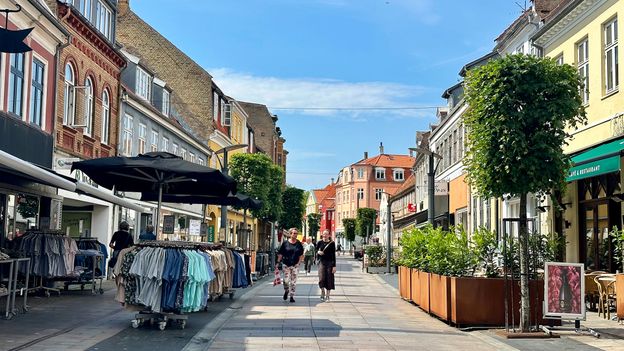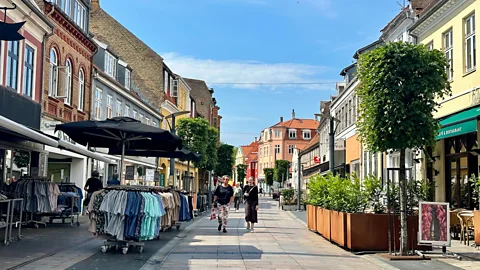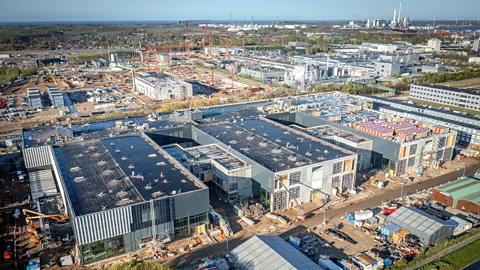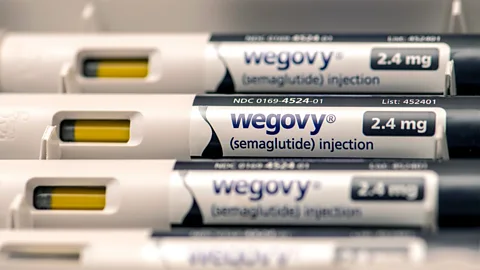

Adrienne Murray
Surging American Interest in Weight-Loss Medications is Revving Up Denmark’s Economy, Elevating a Small Community into a Surprising Boomtown.
Just two years ago, the name Novo Nordisk was largely unfamiliar. Today, however, the dramatic rise in sales of their popular drugs, Wegovy and Ozempic, aimed at combating obesity and diabetes, has elevated this biopharmaceutical company to one of Europe’s most valuable businesses.
This surge in demand has significantly invigorated the Danish economy, making it among the fastest-growing in the region. The impact is visible in new job opportunities and decreased mortgage rates across the country, notably in the quaint port town of Kalundborg. Here, a historic investment is currently underway—one of the largest in Denmark’s commercial history.
As you arrive in Kalundborg, located about an hour northwest of Copenhagen, the sounds of birds and construction fill the air. This may seem an unexpected location for the epicenter of a worldwide weight-loss revolution.
Across the railway bridge, the stark, industrial structures of Novo Nordisk’s extensive facility come into view—it’s here that approximately half of the world’s insulin is manufactured, along with semaglutide, the transformative ingredient in Ozempic and Wegovy.
“We are at the core where medicine originates,” stated Mayor Martin Damm, as we walked along the expansive perimeter of the facility, which spans an impressive 1.6 million square meters—equivalent to 224 soccer fields.
“You are now entering crane territory,” Damm announced, referring to the numerous construction cranes towering above new concrete structures and temporary buildings.
A staggering $8.6 billion (DKK 60 billion) will be invested here over the upcoming years, predicted to create 1,250 new jobs for a workforce that already numbers 4,400. Additionally, 3,000 construction jobs are being generated in the vicinity. “Generally in our industry, one job created internally leads to three external jobs,” said Damm.

Getty Images
An astonishing two-thirds of Denmark’s GDP growth originated from just four municipalities, all of which host Novo Nordisk facilities. Kalundborg alone experienced an extraordinary 27% growth rate in 2022, marking it as the top performer. According to Damm, “This shift has led to low unemployment in a region that previously faced high rates.”
The increase in corporate taxes from Novo Nordisk’s growth has bolstered Kalundborg’s finances, allowing for the development of a community swimming area and plans for a new cultural center and library. Additionally, over 1,250 new homes are set to be constructed, along with a new motorway to Copenhagen being initiated.
However, alongside these financial gains, local primary schools are struggling with subjects like mathematics, and there is a higher prevalence of overweight children, drawing some critiques.
Local residents expressed some skepticism about reaping immediate benefits from this economic boom. “Businesses come and go, and that’s the situation we find ourselves in,” noted Lonny Frederiksen, the owner of a local hair salon. He adds, “Nevertheless, there are more opportunities for young people today.”
Many residents commute rather than live in Kalundborg, which Gitte Pedersen points out increases traffic congestion. “There are times when the wait in traffic is overwhelming,” she admits, while remaining hopeful, stating, “This will undoubtedly create numerous job opportunities. We will see notable changes in a few years.”
Unprecedented Demand for Weight-Loss Drugs
For a century, Novo Nordisk primarily focused on insulin production, but the discovery of semaglutide’s weight-loss capabilities has marked a major shift in their business model. Kurt Jacobsen, a professor at Copenhagen Business School and author of a book about the company, states, “The industry is transitioning into an entirely new entity.”
Wegovy and Ozempic are part of a drug class known as GLP-1s, which assist in regulating blood sugar levels and curbing appetite. Ozempic received approval in the U.S. in 2017, followed by Wegovy in 2021, which is now available in thirteen countries, including China.
Currently, over half of Novo Nordisk’s revenue is generated in the U.S., where thousands subscribe weekly for Wegovy prescriptions. With a price tag exceeding $1,000 (£746, €958) monthly in the U.S., it starkly contrasts the $92 (£73 / €88) cost in Germany, with many insurers opting not to cover the treatment.
During a congressional hearing last year, Senator Bernie Sanders confronted Novo Nordisk’s CEO, Lars Frugaard Jørgensen, regarding the inflated prices in America, demanding they “Stop overcharging us!” In response, the firm attributed the higher costs to the complexities and “middlemen” in the U.S. healthcare system.

Getty Images
Globally, around 800 million individuals face obesity, with projections indicating the weight-loss treatment market could reach $150 billion (£144 billion) by 2030. This burgeoning market is driving a pharmaceutical gold rush as major companies pursue the next wave of weight-loss medications. Currently, Novo Nordisk and American competitor Eli Lilly are leading the charge but face challenges in meeting the tremendous demand. To ramp up production, Novo Nordisk is executing an extensive investment plan worth several billion dollars, expanding factories both domestically and abroad, including new facilities in France and the U.S., while also acquiring three manufacturing plants from American firm Catulent.
Significant Impact on a Small Economy
Novo Nordisk’s rapid ascent has had a substantial influence on Denmark, a nation with a population of fewer than six million. According to Las Olsen, chief economist at Danske Bank, “While other firms like Maersk contribute significantly, none rival Novo Nordisk’s scale.”
In 2023, Denmark emerged as one of Europe’s fastest-growing economies with a GDP increase of 2.5%, half of which was attributed to the pharmaceutical sector. Following substantial gains from drug exports, the government forecasts a 3.0% growth for 2024 and expects to maintain a 2.9% growth rate this year. Novo Nordisk stands as the country’s largest taxpayer, responsible for a fifth of all new jobs, with many Danish citizens and pension funds owning shares.
“Denmark reflects Europe’s trends but remains slightly stronger, which is amplified by Novo Nordisk’s success,” states Olsen.
The influx of dollars from international sales has strengthened Denmark’s krone, contributing to lower loan costs. “Interest rates are now slightly lower than in the eurozone, largely due to this influx of cash,” explains Olsen.
Conversely, there have been fluctuations in the stock market, with initial excitement over two new anti-obesity drugs waning after disappointing clinical trials, leading to major sell-offs. This drop even temporarily weakened Denmark’s currency; however, promising early results from another weekly injection have since lifted stock prices.
Concerns have also been raised about Novo Nordisk’s rapid expansion and its potential implications for the Danish economy, drawing parallels to Finland’s decline after Nokia’s failure to adapt in 2007. Nevertheless, many experts remain optimistic about the long-term outlook.
“Most experts agree that the chances of such an outcome are low,” reflects Carl-Johan Dalgaard, chair of Denmark’s Economic Council. “Should the economy be anchored by industrial leaders, most would view that positively.”
However, as a small number of major corporations increasingly dominate the economy, potential risks arise, as Dalgaard explains: “The concern grows that with economic power comes political sway, which could affect policy-making.”

Adrienne Murray
Emerging risks loom on the horizon; amid escalating tensions regarding Greenland, U.S. President Donald Trump has hinted at possible tariffs on Danish products. Danish Prime Minister Mette Frederiksen recently convened a gathering of leaders from the nation’s largest firms to address the situation. “Indications from the U.S. suggest that there may be a shift towards reduced collaboration,” says Frederiksen.
Novo Nordisk’s CEO, Jørgensen, was part of the meeting, and he later stated to reporters following the company’s earnings release on February 5, 2025, that the company is well-prepared but “not impervious” to such developments.
“Tariffs are inherently detrimental,” remarked Jacob Funk Kirkegaard from the Peterson Institute for International Economics. Yet he maintains, “Among EU nations, Denmark is likely the most resilient against U.S. tariffs. A sophisticated entity like Novo Nordisk, with its operations beyond Denmark, would likely adapt effectively.”
“In five years, this place will look completely different”
In addition to Novo Nordisk, other significant global players like shipping giant Maersk, brewer Carlsberg, and toy manufacturer Lego have emerged from Denmark, many backed by charitable foundations. This structure promotes long-term sustainability and deters companies from being fragmented, explains Mette Feifer, vice president of the Danish Chamber of Commerce. “Without foundation ownership, Novo Nordisk might have been sold off a decade or two ago.”
In Kalundborg, a new educational facility dedicated to training future life sciences professionals has been established. Known as Helix Lab, this institution, funded by the Novo Nordisk Foundation, offers master’s students access to research labs and practical experience with local biotech firms.

Adrienne Murray
Maria Riquelme Jimenez, a chemical engineering student from Mexico, expressed excitement about the proximity to industry, saying, “Being able to engage directly with companies enhances our learning experience.”
Anette Birck, the director of Helix Lab, noted, “It provides students a competitive edge in their future careers and attracts talent while creating local opportunities for Kalundborg youth.”
Overlooking the picturesque waterfront in Kalundborg, Costa Kalundborg Kaffe, operated by Shaun Gamble from New Zealand, has noticed an increase in customer traffic and a rise in international student residency in the area. “The scale of development in this small town is astonishing,” he affirms. “There’s a change underway. It’s still nascent, but I can sense it. In five years, this place will be completely transformed—for the better.”










